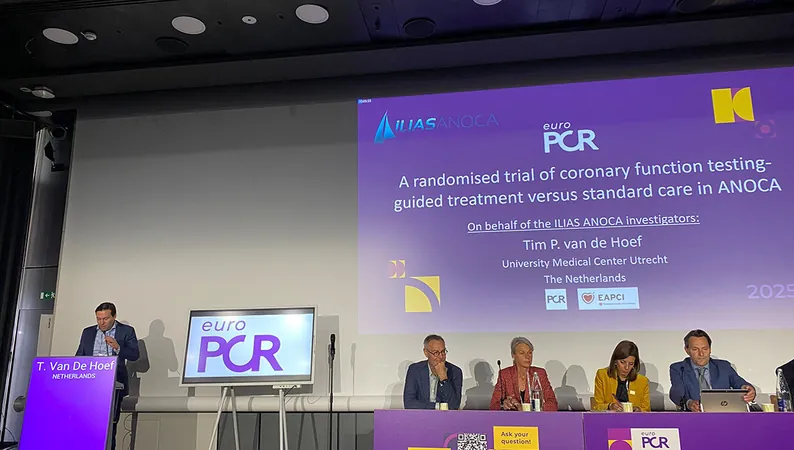
Revolutionary Findings: Early Testing Boosts Quality of Life for Angina Sufferers
2025-05-28
Author: Siti
A Game-Changer for ANOCA Patients
In an exciting development presented at EuroPCR in Paris, a groundbreaking study reveals that early coronary function testing (CFT) can dramatically enhance the quality of life for patients suffering from angina caused by non-obstructive coronary artery disease (ANOCA). This research, part of the ILIAS ANOCA trial, highlights the feasibility and safety of CFT conducted during initial angiography, suggesting it outperforms standard care.
Stunning Results from the ILIAS ANOCA Trial
Among the 153 patients involved in the trial, an impressive 78% were identified with coronary vasomotor dysfunction through CFT. More compellingly, those who underwent CFT experienced a significant improvement in their Seattle Angina Questionnaire Summary Score (SAQSS) over six months compared to those receiving standard care.
Tim van de Hoef from University Medical Center Utrecht emphasized that these findings solidify the case for early coronary function testing, noting it allows patients to achieve a clearer diagnosis and enhances their satisfaction with treatment.
Pragmatic and Patient-Centered Approach
This innovative study was praised for its pragmatic approach, ensuring patients could continue their medical therapy without interruption. Referring physicians received crucial CFT diagnoses alongside a detailed medical therapy guide, improving treatment decisions.
Guidelines Support Functional Testing for ANOCA
Current European guidelines advocate for invasive coronary angiography paired with functional testing, marking it as essential in clarifying diagnoses of obstructive disease or ANOCA. U.S. guidelines also prize invasive functional testing to enhance diagnosis accuracy in patients with persistent chest pain.
The ILIAS ANOCA Trial Details
The trial included a diverse group of participants with an average age of 63, predominantly female. CFT encompassed advanced techniques like coronary flow reserve measurements and acetylcholine provocation without interrupting ongoing therapies. Patients were split into two groups: one received CFT-guided treatment, while the other remained blind to CFT results.
Impressive Gains in Quality of Life
Results showed that CFT could identify specific issues in patients—42% demonstrated isolated coronary spasm, while 20% experienced mixed spasm and coronary microvascular dysfunction. Importantly, those in the intervention group reported a remarkable 9.4-point increase in SAQSS compared to the control group, coupled with significant improvements in quality of life and angina frequency.
Safety and Efficacy of CFT Confirmed
The testing process proved efficient, averaging just 21 minutes with zero adverse events reported. This study boldly suggests that early and effective intervention can reshape treatment approaches and outcomes for individuals grappling with ANOCA.
Implications for Future Research
Looking forward, further studies are set to explore how these insights may alter treatment outcomes, providing hope for improved management strategies for angina patients. With this vital research, the landscape of cardiovascular care for ANOCA could be on the brink of a transformative change.



 Brasil (PT)
Brasil (PT)
 Canada (EN)
Canada (EN)
 Chile (ES)
Chile (ES)
 Česko (CS)
Česko (CS)
 대한민국 (KO)
대한민국 (KO)
 España (ES)
España (ES)
 France (FR)
France (FR)
 Hong Kong (EN)
Hong Kong (EN)
 Italia (IT)
Italia (IT)
 日本 (JA)
日本 (JA)
 Magyarország (HU)
Magyarország (HU)
 Norge (NO)
Norge (NO)
 Polska (PL)
Polska (PL)
 Schweiz (DE)
Schweiz (DE)
 Singapore (EN)
Singapore (EN)
 Sverige (SV)
Sverige (SV)
 Suomi (FI)
Suomi (FI)
 Türkiye (TR)
Türkiye (TR)
 الإمارات العربية المتحدة (AR)
الإمارات العربية المتحدة (AR)